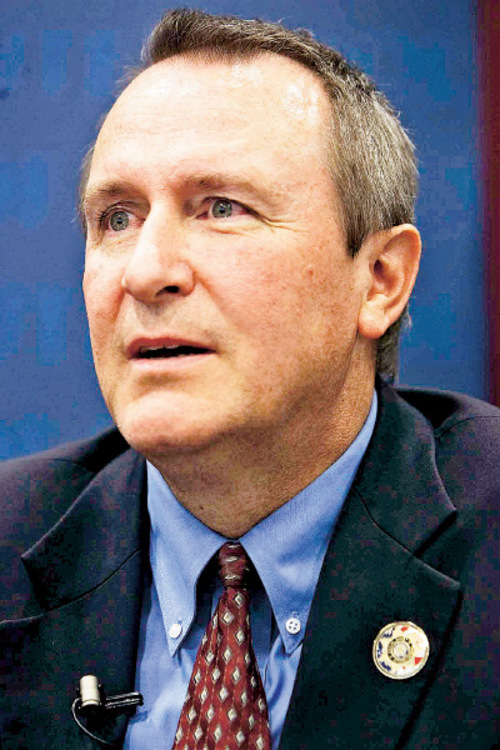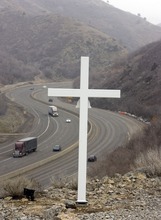This is an archived article that was published on sltrib.com in 2011, and information in the article may be outdated. It is provided only for personal research purposes and may not be reprinted.
The Utah Highway Patrol Association isn't giving up the fight to keep 12-foot-high crosses intended to memorialize state troopers killed in the line of duty visible to the public.
The association is still reeling from a recent decision by U.S. Supreme Court justices, who declined to hear the contentious First Amendment case over the appropriateness of the memorials on public land. The decision means that 10 of the 14 white crosses that currently sit on public land, either outside UHP offices or alongside a highway, must come down or be moved to private property.
All 14 of the crosses, whether on public or private lands, must have the UHP insignia removed.
Representatives from the Utah Highway Patrol Association (UHPA), Utah Attorney General Mark Shurtleff and several family members of troopers whose names appear on the crosses spoke Wednesday about the issue during a "town hall meeting" broadcast on The Doug Wright show on KSL Newsradio.
Among the ideas proposed to keep the crosses where they are: Get the Utah State Legislature to change the land where the crosses are sitting into private property.
"Is there a way to sell this property to the [UHPA] so it's on private property so we don't have to move them?" said Rep. Lee Perry, a Republican from Perry, who is also a 23-year veteran and lieutenant for the Utah Highway Patrol. He said the association has "great support from legislators on the hill" and said he believes the roadside memorials should be a state issue and not under restrictions from the federal government.
Frank Mylar, an attorney who represents the association, said on Wright's show that the association immediately removed UHP logos following the high court's decision in October. Crosses on private property are in compliance with the court's decision after the Utah beehive logo was painted out, Mylar said. Each cross also now has a taped "reminder" that it is a privately funded memorial.
The association is continuing to grapple with what to do with crosses on public land as it waits for an order from the federal court stipulating a time frame for changes to the memorials.
The UHPA is planning a Monday meeting to discuss its options for the memorials, said Shurtleff, who had pushed the high court to take on the case, arguing that the highway crosses should be displayed.
"With two simple lines the highway crosses remind us of the ultimate sacrifice made by troopers while trying to protect us," Shurtleff has said. "Before now, no other court has ever held that memorial crosses establish a religion. The crosses only establish a trooper died in the line of duty."
Brian Barnard, a Salt Lake City civil rights attorney who represents the organization against placing crosses on public land, said following Wright's show that attempts to circumnavigate the Supreme Court's decision — such as trying to make the public land suddenly private — will likely only result in more lawsuits.
"Such methods have been tried with other religious displays in other states and have not been successful," Barnard said. "Rather than spending more taxpayer money on litigation, the state should use that money for scholarships and for aid to the families of the troopers."
Wednesday's comments were the latest in a long battle over the alleged display of religious imagery on public land between the UHPA and American Atheists Inc., the organization represented by Barnard.
The case began when American Atheists and three of its Utah members sued the state in 2005 for allowing the association to incorporate the UHP logo on the crosses and place some of them on public property.
The trooper's name, rank and badge number are printed on a 6-foot crossbar, and a large depiction of the UHP's beehive symbol initially had hung below where the two bars met. The first cross was erected in 1998 on private property and 13 others were added later, most of them on public property. The memorials are privately funded and owned by the UHPA, while the state owns the public land on which some of them sit.
A 10th Circuit Court of Appeals ruling in January to allow the stay followed a 5-4 December decision by the same court to deny a request to hear the case from the UHPA.
The UHPA had wanted the court to reverse an earlier ruling that the crosses are unconstitutional.
Support was needed from nine justices to have the case heard by the U.S. Supreme Court. Only Justice Clarence Thomas supported hearing the appeal, a position he detailed in a 19-page dissent.
Thomas wrote that he saw the case as an "opportunity to provide clarity to an Establishment Clause jurisprudence in shambles," citing diverging case law concerning the constitutional language that protects against government establishing or endorsing a religion.
In his dissent, Thomas criticized the 10th Circuit's opinion that an observer might see the crosses and believe the "Utah Highway Patrol and Christianity had 'some connection,' leading him to 'fear that Christians are likely to receive preferential treatment from the [patrol].' "
Following the Supreme Court ruling last month, Shurtleff called the high court's decision not to hear the case a missed opportunity to tackle Establishment Clause issues.
"Ultimately, the Supreme Court is going to have to have a nationwide ruling on this and this was a chance to do that," Shurtleff said. "We continue with the irony that the Supreme Court meets every day under Moses and the Ten Commandments [which are depicted in stone on the outside of the U.S. Supreme Court building]. They've made it very clear you can have religious symbols in the public sector. But that's now left to each city and county and state. It's going to lead to more litigation."
American Atheists President David Silverman, meanwhile, said "the American public has been spared a drama" with the court's decision.
Both Barnard and Silverman have expressed hope that the UHPA will find more "suitable alternatives" for the fallen officers' memorials.
"We hope and expect the [UHPA] to not just take down the crosses but actually replace them with suitable memorials," Silverman said. "We want the fallen troopers to be honored. ... These people died serving their country and they should be honored in a way that upholds the Constitution they died protecting."
"Troopers can be and should be honored with a symbol that is inclusive of all Utahns," Barnard said in a news release. "A state-approved memorial should represent those who are not religious as well as those who are. The memorials should not emphasize one religious faith to the exclusion of all others. A memorial symbol endorsed by the state should not be religious but should be universal."
Families whose loved ones are remembered on the crosses disagree.
Brian Hutchings, whose father was shot to death in 1976 after entering a house during a drug raid, said his family is hurt that the crosses memorializing law enforcement must be changed. Robert B. Hutching's memorial sits at the UHP field office in Murray and was recently vandalized.
Brian Hutchings was five when his father died; his mother was pregnant with the family's seventh child, he said. When he drives by the cross in Murray, he offers a quiet hello to the memorial, he said during Wright's show.
"I get to drive by here and say 'hi'," Hutchings said. "And it means a lot to me."
Twitter: @mrogers_trib —
Where the crosses are and who they honor
William J. Antoniewicz • died 1974, cross is near rest stop in Echo Canyon on Interstate 80
Joseph S. Brumett III, 1992, and Robert B. Hutchings, 1976 • UHP field office in Murray
Daniel W. Harris • 1982, Parleys Canyon on I-80, milepost 132
Randy K. Ingram • 1994, Interstate 15 near Nephi, milepost 207
Ray L. Pierson, 1978, and Armond A. Luke, 1959 • intersection of Highway 89 and State Route 20, Garfield County
Dennis L. Lund • 1993, rest stop on Interstate 70, about 8 miles west of State Route 6 junction
George D. Rees, 1960, and Thomas S. Rettberg, 2000 • I-15 rest stop in Farmington, milepost 327
Doyle R. Thorne • 1994, quarter-mile east of Currant Creek Junction on Highway 40, Duchesne County
George E. Van Wagenen, 1931, and John R. Winn, 1971 • Main Street in Lehi next to railroad museum
Charles Warren • 1994, I-15 in Springville, milepost 262





